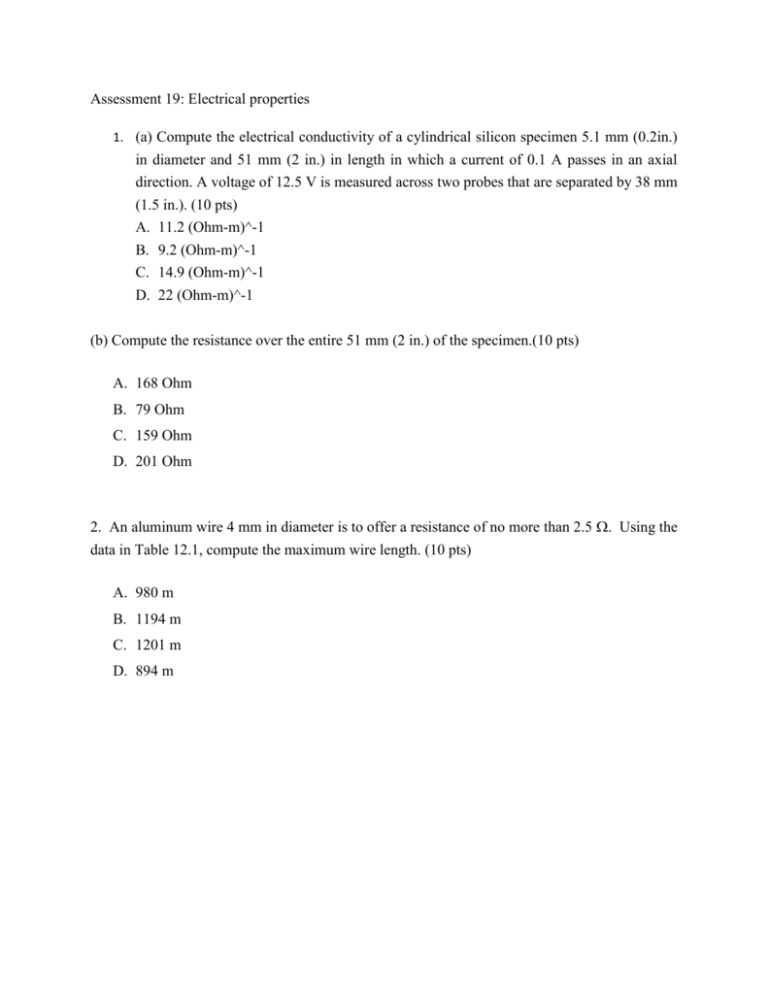Assessment 19: Electrical properties (a) Compute the electrical
advertisement

Assessment 19: Electrical properties 1. (a) Compute the electrical conductivity of a cylindrical silicon specimen 5.1 mm (0.2in.) in diameter and 51 mm (2 in.) in length in which a current of 0.1 A passes in an axial direction. A voltage of 12.5 V is measured across two probes that are separated by 38 mm (1.5 in.). (10 pts) A. 11.2 (Ohm-m)^-1 B. 9.2 (Ohm-m)^-1 C. 14.9 (Ohm-m)^-1 D. 22 (Ohm-m)^-1 (b) Compute the resistance over the entire 51 mm (2 in.) of the specimen.(10 pts) A. 168 Ohm B. 79 Ohm C. 159 Ohm D. 201 Ohm 2. An aluminum wire 4 mm in diameter is to offer a resistance of no more than 2.5 . Using the data in Table 12.1, compute the maximum wire length. (10 pts) A. 980 m B. 1194 m C. 1201 m D. 894 m 3. Place the type of electron energy band structure to the material type A. No empty electron states adjacent to and above the filled state. The energy gap to the next band state is significantly large B. No empty electron states adjacent to and above the filled state. The energy gap to the next band state is small C. Vacant electron energy states adjacent to the highest fill state Metals (5 pts) – Insulators (5 pts) Semiconductors(5 pts) – 4. Calculate the drift velocity of electrons in germanium at room temperature and when the magnitude of the electric field is 1000 V/m. (5 pts) A. 410 m/s B. 295 m/s C. 380 m/s D. 305 m/s 5. At room temperature the electrical conductivity of PbTe is 500 (Ω-m)–1, whereas the electron and hole mobilities are 0.16 and 0.075 m2/V-s, respectively. Compute the intrinsic carrier concentration for PbTe at room temperature. (10 pts) A. 4.05 x 10^22 m^-3 B. 2.22 x 10^22 m^-3 C. 1.33 x 10^22 m^-3 D. 5.21 x 10^22 m^-3 6. (a) The room-temperature electrical conductivity of a silicon specimen is 5.93 10–3 (Ωm)–1. The hole concentration is known to be 7.0 1017 m–3. Using the electron and hole mobilities for silicon in Table 12.3, compute the electron concentration. (10 pts) A. 1.44 x 10 ^16 m^-3 B. 2.23 x 10 ^15 m^-3 C. 5.01 x 10 ^17 m^-3 D. 7.88 x 10 ^16 m^-3 (b) On the basis of the result in part (a), is the specimen intrinsic, n-type extrinsic, or ptype extrinsic? (5 pts) A. intrinsic B. n-type extrinsic C. p-type extrinsic 7. Estimate the electrical conductivity at 125°C of silicon that has been doped with 1023 m–3 of aluminum atoms. (10 pts) A. 304 (Ohm-m)^-1 B. 256 (Ohm-m)^-1 C. 272 (Ohm-m)^-1 D. 501(Ohm-m)^-1







